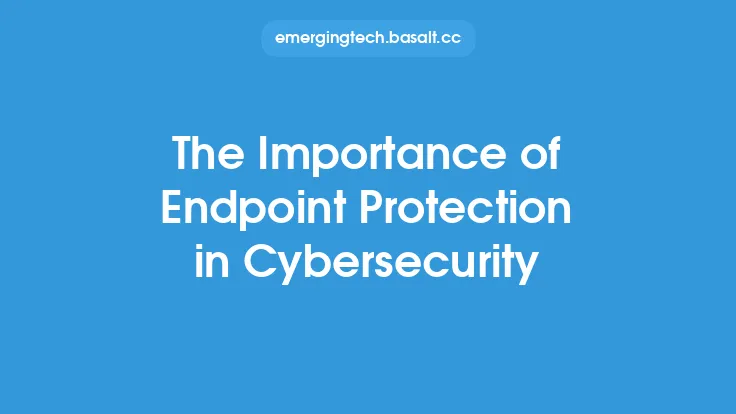Implementing endpoint security measures is a crucial aspect of any organization's cybersecurity strategy. Endpoints, which include devices such as laptops, desktops, mobile devices, and servers, are the most vulnerable points of entry for cyber threats. By securing these endpoints, organizations can prevent attacks, protect sensitive data, and ensure the continuity of their operations. In this article, we will explore the benefits of implementing endpoint security measures and discuss the various techniques and technologies used to achieve endpoint security.
What is Endpoint Security?
Endpoint security refers to the practice of securing endpoints from cyber threats. This involves using a combination of technologies, processes, and procedures to prevent, detect, and respond to threats. Endpoint security measures can include firewalls, antivirus software, intrusion detection systems, and encryption, among others. The goal of endpoint security is to prevent unauthorized access to endpoints, protect sensitive data, and prevent the spread of malware.
Benefits of Implementing Endpoint Security Measures
Implementing endpoint security measures provides numerous benefits to organizations. Some of the most significant benefits include:
- Prevention of Cyber Attacks: Endpoint security measures can prevent cyber attacks by blocking malware, viruses, and other types of threats. This helps to protect sensitive data and prevent financial losses.
- Protection of Sensitive Data: Endpoint security measures can protect sensitive data by encrypting it and controlling access to it. This helps to prevent data breaches and ensure the confidentiality, integrity, and availability of sensitive data.
- Compliance with Regulations: Implementing endpoint security measures can help organizations comply with regulatory requirements. Many regulations, such as HIPAA and PCI-DSS, require organizations to implement certain security measures to protect sensitive data.
- Improved Incident Response: Endpoint security measures can help organizations respond quickly and effectively to security incidents. This helps to minimize the impact of security incidents and prevent them from spreading.
- Reduced Downtime: Implementing endpoint security measures can help reduce downtime by preventing cyber attacks and minimizing the impact of security incidents. This helps to ensure the continuity of business operations and prevent financial losses.
Techniques and Technologies Used in Endpoint Security
Several techniques and technologies are used in endpoint security to prevent, detect, and respond to threats. Some of the most common techniques and technologies include:
- Firewalls: Firewalls are used to block unauthorized access to endpoints and prevent the spread of malware.
- Antivirus Software: Antivirus software is used to detect and remove malware from endpoints.
- Intrusion Detection Systems: Intrusion detection systems are used to detect and alert on potential security threats.
- Encryption: Encryption is used to protect sensitive data by making it unreadable to unauthorized users.
- Access Control: Access control is used to control who has access to endpoints and what actions they can perform.
- Patch Management: Patch management is used to ensure that endpoints are up-to-date with the latest security patches.
- Vulnerability Management: Vulnerability management is used to identify and remediate vulnerabilities in endpoints.
Best Practices for Implementing Endpoint Security Measures
Implementing endpoint security measures requires a combination of technical and procedural controls. Some best practices for implementing endpoint security measures include:
- Conducting Regular Risk Assessments: Conducting regular risk assessments helps to identify vulnerabilities and threats to endpoints.
- Implementing a Defense-in-Depth Strategy: Implementing a defense-in-depth strategy helps to prevent attacks by using multiple layers of security controls.
- Using Strong Authentication and Authorization: Using strong authentication and authorization helps to control access to endpoints and prevent unauthorized access.
- Keeping Endpoints Up-to-Date: Keeping endpoints up-to-date with the latest security patches and software updates helps to prevent vulnerabilities and threats.
- Monitoring Endpoints for Security Threats: Monitoring endpoints for security threats helps to detect and respond to security incidents quickly and effectively.
Challenges and Limitations of Implementing Endpoint Security Measures
Implementing endpoint security measures can be challenging and has several limitations. Some of the most significant challenges and limitations include:
- Complexity: Implementing endpoint security measures can be complex and require significant technical expertise.
- Cost: Implementing endpoint security measures can be costly and require significant investment in technology and personnel.
- User Behavior: User behavior can be a significant challenge in implementing endpoint security measures. Users may not follow security policies and procedures, which can put endpoints at risk.
- Evolving Threats: Cyber threats are constantly evolving, which can make it challenging to keep endpoint security measures up-to-date and effective.
- Limited Resources: Small and medium-sized businesses may have limited resources, which can make it challenging to implement and maintain endpoint security measures.
Conclusion
Implementing endpoint security measures is a critical aspect of any organization's cybersecurity strategy. By using a combination of techniques and technologies, organizations can prevent cyber attacks, protect sensitive data, and ensure the continuity of their operations. While there are challenges and limitations to implementing endpoint security measures, the benefits far outweigh the costs. By following best practices and staying up-to-date with the latest threats and technologies, organizations can ensure the security and integrity of their endpoints.





